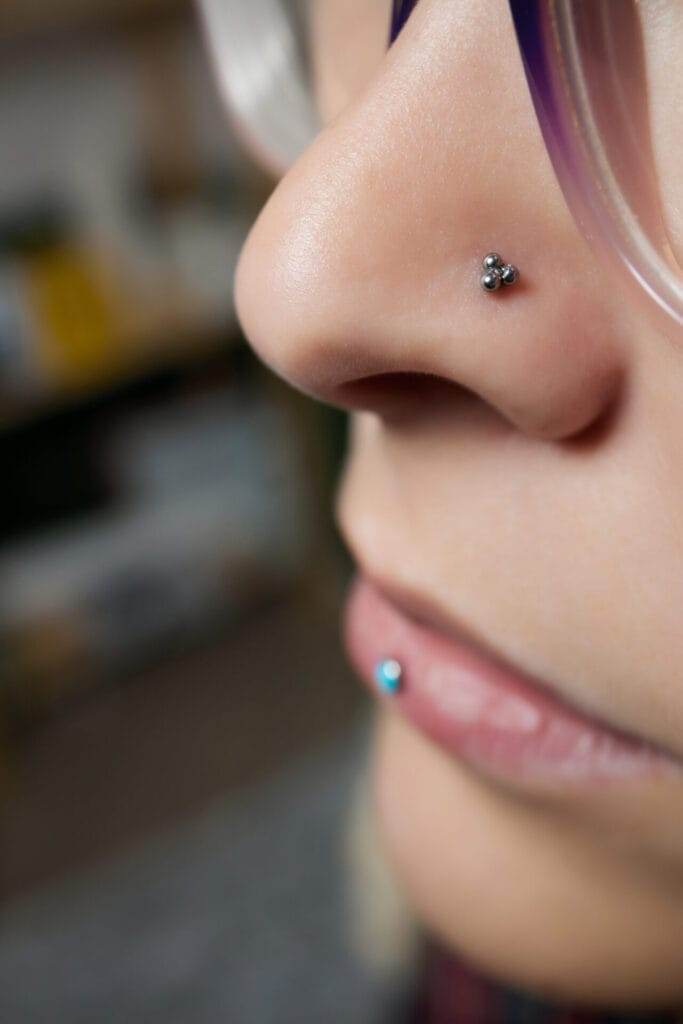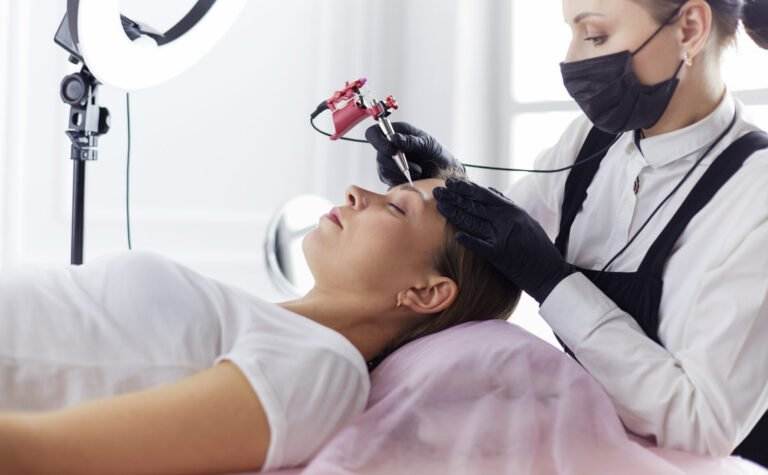Piercings have become increasingly popular in recent years, with people of all ages and backgrounds embracing this form of body modification. Whether it’s a simple earlobe piercing or a more intricate design, piercings have become a way for individuals to express their personal style and add a unique touch to their appearance. However, before diving into the world of piercings, it’s important to understand the art and science behind the process. In this blog post, we will explore the basics of piercing, from the anatomy of the skin to the different types of jewelry available. We will also discuss how to find a reputable piercing studio, the most popular piercing styles, pain management techniques, aftercare essentials, and the risks and complications associated with piercings. By the end of this article, you will have a comprehensive understanding of piercings and be ready to embark on your own piercing journey.
The Art and Science of Piercing: Understanding the Basics
Piercing is both an art and a science. It requires skillful technique and an understanding of the body’s anatomy to ensure a safe and successful piercing. The process typically involves using a hollow needle to create a hole in the skin, which is then filled with jewelry. It’s crucial that the piercing is done by a professional who has been trained in proper technique and sterilization practices.
The anatomy of the skin plays a significant role in determining where a piercing can be placed. Different areas of the body have varying thicknesses of skin and underlying structures, such as cartilage or blood vessels. For example, earlobe piercings are relatively simple because they only involve piercing through soft tissue. On the other hand, cartilage piercings require more precision and care due to the denser nature of cartilage.
When it comes to piercing needles and jewelry, there are several options available. The most common type of needle used is a hollow needle, which creates a clean hole and minimizes tissue damage. There are also different sizes of needles, depending on the desired piercing and the thickness of the jewelry. As for jewelry, there are various materials to choose from, including titanium, gold, and acrylic. Each material has its own advantages and considerations, such as hypoallergenic properties and durability.
Popular Piercing Styles: From Earlobe to Cartilage and Beyond
There are numerous types of piercings to choose from, ranging from simple earlobe piercings to more complex cartilage or body piercings. Earlobe piercings are the most common type of piercing and involve piercing through the soft tissue of the earlobe. They are relatively quick to heal and offer a wide variety of jewelry options.
Cartilage piercings are another popular choice, with helix piercings being one of the most common types. Helix piercings involve piercing the upper cartilage of the ear, creating a unique and stylish look. Other cartilage piercings include tragus, conch, and daith piercings, each with its own placement and healing considerations.
Nose piercings, particularly nostril piercings, have also gained popularity in recent years. They can be done on either side of the nostril and offer a versatile range of jewelry options, such as studs, hoops, and rings. Navel piercings are another trendy choice, especially during the summer months when they can be shown off with crop tops or bikinis.
In addition to these common piercings, there are also less common types such as dermal and surface piercings. Dermal piercings involve placing an anchor under the skin and attaching jewelry to it. Surface piercings are done on flat areas of the body, such as the collarbone or wrist. These types of piercings require careful consideration and expertise due to their unique placement and healing requirements.
Body Jewelry 101: Materials, Sizes, and Styles

Choosing the right body jewelry is an important part of the piercing process. There are various materials to choose from, each with its own advantages and considerations. Titanium is a popular choice for body jewelry due to its hypoallergenic properties and durability. It’s also lightweight and resistant to corrosion. Gold is another common material used for body jewelry, with options ranging from 14k gold to solid gold. Gold is known for its elegance and versatility but may not be suitable for those with metal allergies. Acrylic is a more affordable option that comes in a wide range of colors and styles. However, it’s important to note that acrylic jewelry should not be used for initial piercings or in healed piercings.
When it comes to sizes and styles of body jewelry, there are numerous options to choose from. Studs are a classic choice and are available in various sizes and designs. Hoops and rings offer a more versatile look and can be worn in different piercings, such as the nose or ear. Barbells are commonly used for tongue, nipple, and certain genital piercings. They consist of a straight bar with a ball on each end. It’s important to choose the right size of jewelry for your piercing to ensure a comfortable fit and proper healing.
Pain Management Techniques: How to Minimize Discomfort
Pain is often a concern for individuals considering getting a piercing. While everyone’s pain tolerance is different, there are several techniques that can help minimize discomfort during the piercing process. Deep breathing is one effective technique that can help relax the body and distract from the pain. Taking slow, deep breaths before and during the piercing can help calm the nervous system and reduce pain perception.
Numbing creams or gels can also be used to minimize pain during the piercing process. These topical anesthetics are applied to the skin before the piercing and work by numbing the area. It’s important to note that not all piercing studios allow the use of numbing creams, so it’s best to check with your piercer beforehand.
Aftercare practices can also play a role in minimizing discomfort during the healing process. Proper cleaning and care of the piercing site can help prevent infection and promote healing, which in turn reduces discomfort. Following the aftercare instructions provided by your piercer is crucial for a smooth healing process.
Aftercare Essentials: Keeping Your Piercing Clean and Healthy
Proper aftercare is essential for keeping your piercing clean and healthy. It’s important to follow the aftercare instructions provided by your piercer to ensure a successful healing process. Here are some general aftercare practices to keep in mind:
– Clean the piercing site twice a day with a saline solution or a mild, fragrance-free soap. Gently clean around the jewelry, removing any crust or debris.
– Avoid touching the piercing with dirty hands and avoid unnecessary twisting or turning of the jewelry.
– Avoid swimming in pools, hot tubs, or bodies of water during the initial healing period to prevent infection.
– Avoid sleeping on the piercing to minimize irritation and pressure on the jewelry.
– Be mindful of clothing and accessories that may come into contact with the piercing, such as hats or scarves.
It’s important to note that each piercing may have specific aftercare requirements, so it’s best to consult with your piercer for personalized instructions. If you experience any signs of infection, such as excessive redness, swelling, or discharge, it’s important to seek medical attention.
Piercing Risks and Complications: What You Need to Know
While piercings are generally safe when done by a professional and proper aftercare is followed, there are potential risks and complications to be aware of. Infection is one of the most common complications associated with piercings. Signs of infection include redness, swelling, pain, and discharge. If left untreated, an infection can lead to more serious complications.
Another potential risk is rejection or migration of the jewelry. This occurs when the body perceives the jewelry as a foreign object and tries to push it out. Signs of rejection include the jewelry moving closer to the surface of the skin or visible scarring around the piercing site. If you notice any signs of rejection, it’s important to consult with your piercer.
Allergic reactions can also occur with certain types of jewelry materials. Nickel allergies are particularly common, so it’s important to choose hypoallergenic materials such as titanium or gold if you have a known sensitivity.
To minimize these risks, it’s important to choose a reputable piercing studio that follows strict sterilization practices. It’s also crucial to follow proper aftercare instructions and seek medical attention if any complications arise.
Piercing Trends and Fashion: Keeping Up with the Latest Looks
Piercings have become more than just a form of body modification – they have become a fashion statement. There are constantly new trends emerging in the world of piercings, allowing individuals to express their personal style and creativity. One popular trend is multiple ear piercings, where individuals adorn their ears with multiple studs, hoops, and rings. This trend allows for endless possibilities and combinations, creating a unique and personalized look.
Septum piercings have also gained popularity in recent years. This type of piercing involves piercing the cartilage between the nostrils, creating a bold and edgy look. Septum piercings can be adorned with various styles of jewelry, such as captive bead rings or clickers.
Piercings can be used to complement and enhance other fashion choices, such as hairstyles or clothing. For example, a helix piercing can be showcased by wearing your hair up or to one side. Navel piercings can add a touch of glamour to a bikini or crop top.
Custom Piercing Services: Creating a Unique and Personalized Style
For those looking for a truly unique and personalized piercing experience, custom piercing services are available. These services allow individuals to design and create their own jewelry, tailored to their specific style and preferences. Custom jewelry can be made from various materials, such as gold or titanium, and can incorporate gemstones or other decorative elements.
The process of designing custom jewelry typically involves working closely with a professional piercer or jewelry designer. They will guide you through the design process, taking into consideration factors such as the placement of the piercing, your personal style, and any specific requests you may have. Once the design is finalized, the jewelry will be created specifically for you.
Custom piercing services offer an opportunity to create a truly one-of-a-kind look that reflects your individuality and personal style. Whether it’s a unique ear cuff or a custom nose ring, the possibilities are endless.
Piercing for All Genders: Breaking Down Stereotypes and Taboos
Piercings have often been associated with certain genders or subcultures, but in recent years, there has been a shift towards inclusivity and breaking down stereotypes. Piercings are no longer limited to one gender or a specific style. People of all genders are embracing piercings as a form of self-expression and personal style.
The growing popularity of piercings among all genders has led to a wider range of jewelry options and styles. Jewelry designers and piercing studios are now offering more gender-neutral designs that can be worn by anyone, regardless of their gender identity. This inclusivity is an important step towards creating a more diverse and accepting piercing culture.

Professionalism and Ethics in Piercing: Ensuring a Safe and Positive Experience
Professionalism and ethics are crucial in the piercing industry to ensure a safe and positive experience for clients. When choosing a piercing studio, it’s important to look for piercers who prioritize professionalism and adhere to strict safety protocols.
Professionalism includes clear communication with the client, providing accurate information about the piercing process, aftercare instructions, and any potential risks or complications. The piercer should also have proper training and certification in piercing techniques and sterilization practices.
Ethics in piercing involve respecting the client’s autonomy and personal choices. A professional piercer should never pressure or coerce a client into getting a piercing they are not comfortable with. Informed consent is essential, meaning that the client should be fully aware of the risks and benefits of the piercing before proceeding.
Piercings have become a popular form of self-expression and personal style, allowing individuals to add a unique touch to their appearance. Understanding the art and science behind piercing is crucial for a safe and successful experience. From choosing a reputable piercing studio to selecting the right jewelry and following proper aftercare practices, there are many factors to consider when getting a piercing. By arming yourself with knowledge and understanding, you can confidently explore the world of piercings and create a look that reflects your individuality and personal style.









